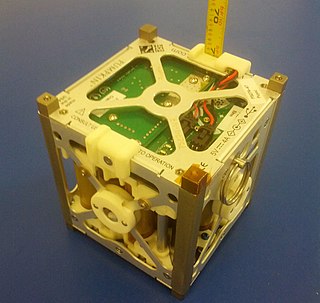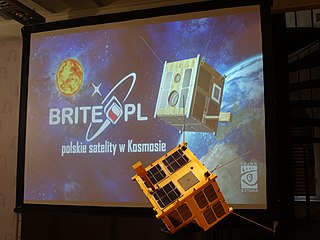
The Polar Satellite Launch Vehicle (PSLV) is an expendable medium-lift launch vehicle designed and operated by the Indian Space Research Organisation (ISRO). It was developed to allow India to launch its Indian Remote Sensing (IRS) satellites into Sun-synchronous orbits, a service that was, until the advent of the PSLV in 1993, only commercially available from Russia. PSLV can also launch small size satellites into Geostationary Transfer Orbit (GTO).

Geosynchronous Satellite Launch Vehicle (GSLV) is a class of expendable launch systems operated by the Indian Space Research Organisation (ISRO). GSLV has been used in fifteen launches since 2001.

For the DNA sequencesee Microsatellite
The Space Test Program (STP) is the primary provider of spaceflight for the United States Department of Defense (DoD) space science and technology community. STP is managed by a group within the Advanced Systems and Development Directorate, a directorate of the Space and Missile Systems Center of the United States Space Force. STP provides spaceflight via the International Space Station (ISS), piggybacks, secondary payloads and dedicated launch services.
The Canadian Advanced Nanospace eXperiment (CanX) program is a Canadian CubeSat nanosatellite program operated by the University of Toronto Institute for Aerospace Studies, Space Flight Laboratory (UTIAS/SFL). The program's objectives are to involve graduate students in the process of spaceflight development, and to provide low-cost access to space for scientific research and the testing of nanoscale devices. The CanX projects include CanX-1, CanX-2, the BRIght Target Explorer (BRITE), and CanX-4&5.
The Nanosatellite Launch System (NLS) is a series of satellite launch missions launched 2003–2010, coordinated by the Space Flight Laboratory (SFL) of the University of Toronto Institute for Aerospace Studies (UTIAS).

SARAL is a cooperative altimetry technology mission of Indian Space Research Organisation (ISRO) and Centre National d'Études Spatiales (CNES). SARAL performs altimetric measurements designed to study ocean circulation and sea surface elevation.

SRMSAT is a Nanosatellite built by faculty and students at Sri Ramaswamy Memorial University in India. The satellite is an Indian Technology demonstration and Earth observation satellite which is operated by the SRM Institute of Science and Technology. This nanosatellite was used to monitor Greenhouse gases in atmosphere.
TUGSAT-1, also known as BRITE-Austria and CanX-3B, is the first Austrian satellite. It is an optical astronomy spacecraft operated by the Graz University of Technology as part of the international BRIght-star Target Explorer programme.
Sapphire is a Canadian space surveillance satellite which was launched in 2013. Sapphire was commissioned and integrated by MacDonald, Dettwiler and Associates (MDA) based on an SSTL-150 bus produced by Surrey Satellite Technology (SSTL) and an optical payload produced by COM DEV International.

Alexander, also known as PhoneSat 2.0 Beta or PhoneSat v2a is a technology demonstration satellite operated by NASA's Ames Research Center, which was launched in April 2013. Part of the PhoneSat programme, it was one of the first three PhoneSat spacecraft, and the first Phonesat-2.0 satellite, to be launched.

Graham, also known as PhoneSat 1.0a or PhoneSat v1a was a technology demonstration satellite operated by NASA's Ames Research Center, which was launched in April 2013. Part of the PhoneSat programme, it was one of the first three PhoneSat spacecraft to be launched.
CUTE-1.7 + APD II, or CUTE-1.7 + APD 2, is a Japanese nanosatellite which was launched in 2008 as a follow-up to the CUTE-1.7 + APD satellite. It was built and is operated by the Tokyo Institute of Technology.

BRITE-Constellation is an ongoing space mission carrying out two-band photometry in wide fields with a constellation of six BRIght Target Explorer (BRITE) nanosatellites. The mission was built by a consortium of three countries, Canada, Austria, and Poland, each operating two BRITE satellites. The six satellites were launched into low-Earth orbits between February 2013 and August 2014. Each satellite is a cube-shaped spacecraft with sides of 20 centimetres (7.9 in) hosting an optical telescope of 3 centimetres (1.2 in) aperture feeding an uncooled CCD with a field of view of approximately 20° × 24°. The satellites were intended for photometry of the brightest stars in single passband located in the blue or red part of the optical range.

Heweliusz is the second Polish scientific satellite launched in 2014 as part of the Bright-star Target Explorer (BRITE) programme. The spacecraft was launched aboard a Chang Zheng 4B rocket in August 2014. Heweliusz is an optical astronomy spacecraft built by the Space Research Centre of the Polish Academy of Sciences and operated by Centrum Astronomiczne im. Mikołaja Kopernika PAN; it is one of two Polish contributions to the BRITE constellation along with the Lem satellite. It is named after Johannes Hevelius.

Lem is the first Polish governmental artificial satellite. It was launched in November 2013 as part of the Bright-star Target Explorer (BRITE) programme. The spacecraft was launched aboard a Dnepr rocket. Named after the Polish science fiction writer Stanisław Lem, it is an optical astronomy spacecraft built by the Space Research Centre of the Polish Academy of Sciences and operated by Centrum Astronomiczne im. Mikołaja Kopernika PAN; one of two Polish contributions to the BRITE constellation along with the Heweliusz satellite.

PSLV-C37 was the 39th mission of the Indian Polar Satellite Launch Vehicle (PSLV) program and its 16th mission in the XL configuration undertaken by the Indian Space Research Organisation (ISRO). Launched on 15 February 2017 from the Satish Dhawan Space Centre at Sriharikota, Andhra Pradesh, the rocket successfully carried and deployed a record number of 104 satellites in Sun-synchronous orbits in a single mission, breaking the earlier record of launching 37 satellites by a Russian Dnepr rocket on 19 June 2014. This record was held until the launch of the Transporter-1 mission by SpaceX on 24 January 2021 which launched 143 satellites.

The PSLV-C45 is the 47th mission of the Indian Polar Satellite Launch Vehicle (PSLV) program. The Polar Satellite Launch Vehicle (PSLV)-C45 was launched on 1 April 2019 with a payload of 29 satellites, including one for electronic intelligence, along with 28 customer satellites from other countries.










